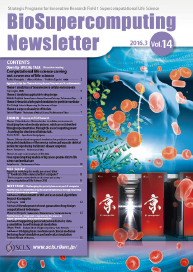The objectives of this Theme are to reproduce the functions of tissues and organs as an assembly of various cells at a level never explored before and, to predict clinical conditions and contribute to medical treatments. For instance, for the brain-nervous and musculo-skeletal system, we have conducted our research with the aim of reproducing the differences in tremor and rigidity, and the postural maintenance disorder in Parkinson,s disease by integrating the NEST, which succeeded in a brain-nervous system simulation consisting of the world’s largest number of neuron cells, the multi-scale skeletal muscle simulator Hi-MUSCLE which reproduces the behaviors of an entire muscle as an assembly of muscle fibers, and the generalized musculo-skeletal simulator K-Body. As to the achievements up to now, we succeeded in reproducing the β-band (approx. 15Hz) tremors in the basal ganglia which are caused by the lack of dopamine and observed it in animal tests using a monkey, and simulated the behavior of the signal that reduces its frequency by half in the thalamus and transmits it from the cerebral cortex to muscle fibers through the spinal cord, resulting in the tremors of hands( see article “Zoom in” on page 9 of this issue).
For simulation of the circulatory system, the achievements made by the multi-scale and multi-physics heart simulator, UT-Heart, are significant. It succeeded in realizing a 3-hierarchy simulation integrating sarcomere, cardiac muscle cells and the entire heart for the first time in the world, making a significant impact to the field of computational science. A video created based on those achievements got the Best Visualization or Simulation Award from the International Conference SIGGRAPH, an authority in the field of CG, in 2015. Up to now, this video has received over 250,000 views on YouTube (English version) (see Fig. below), and this heart simulator is now renowned globally rather than in Japan. Furthermore, the simulator has already entered the stage of predicting clinical conditions using clinical data, and a comparison with clinical results demonstrated its feasibility in accurate postoperative prediction of pediatric congenital heart disease. For simulation of thrombosis, through this project, we proposed new analysis methods to evaluate drug efficacy based on an integrated analysis of simulations and flow chamber experimental results, and obtained new findings concerning the functions of antiplatelet drugs.

Fig. : Image from a video of UT-Heart, which received over 250,000 views on YouTube
Open Up Special Talk : Approach to the four Themes during the past five years and its achievements
Theme 1 Simulations of biomolecules in cellular environments
Theme 2 Simulation applicable to drug design
Theme 3 Hierarchical integrated simulation for predictive medicine
Theme 4 Large-scale analysis of life data

















